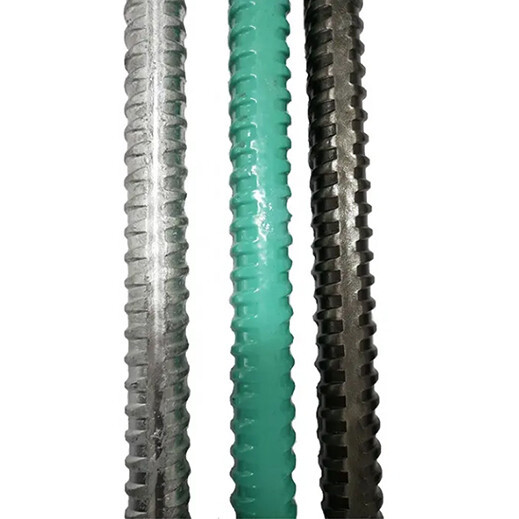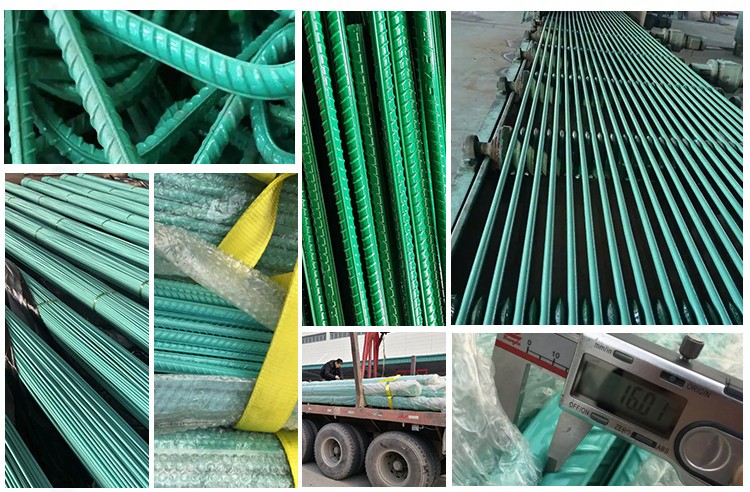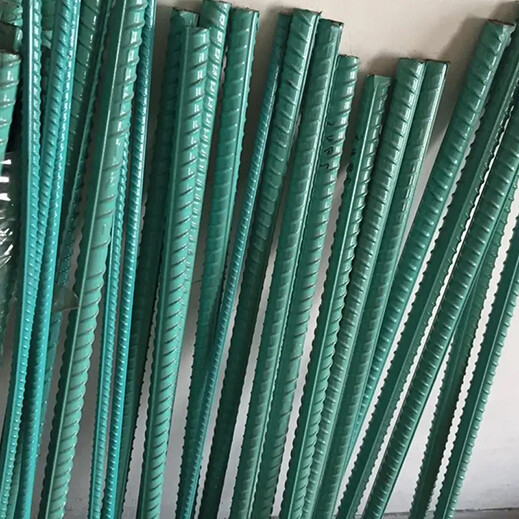PRODUCT
Introduction to Epoxy Coated Rebar
Product Specifications
Factory Showcase
Introduction to Epoxy Coated Rebar
| |
| Epoxy coated rebar, also known as green rebar, is an epoxy resin protective coating prepared on the surface of ordinary rebar by electrostatic spraying powder and high temperature sintering process. The coating has excellent chemical corrosion resistance and does not react with acids and alkalis. The coating is also impermeable and can delay the contact of corrosive media (such as water, oxygen, chloride ions, etc.) with steel, thereby greatly extending its corrosion resistance life. It can replace traditional rebar to reinforce concrete and prevent corrosion. Epoxy coated rebar is used for concrete subject to corrosive conditions, including exposure to deicing salt or marine environment. | |
| 1.Epoxy coated steel bars have the following characteristics and advantages | |
| Anti-corrosion properties | Epoxy coating can effectively isolate corrosive media such as water and oxygen, improve the ability of the structure to resist external corrosion, and extend its service life. |
| Chemical stability | Epoxy coating has good chemical stability, does not react with acids and alkalis, and can withstand the high alkaline environment of concrete for a long time without being damaged. |
| Permeation resistance | The coating is impermeable and can prevent corrosive media (such as water, oxygen, chlorides, etc.) from contacting the steel bars, thereby effectively protecting the steel bars and greatly extending their anti-corrosion life. |
| Construction | The manufacturing process of epoxy coated steel bars is relatively simple, with good construction performance, and is suitable for reinforced concrete structures in various harsh environments. |
| 2.Manufacturing Process | |
| Surface treatment | The rebar is sent to a sandblasting unit to remove all surface contaminants, mill scale and oxide layer. It also roughens the surface to give it a textured anchoring profile (microscopic peaks and small indentations on the surface). |
| Coating | After being blasted and preheated, the rebar passes through a powder spray booth where dry epoxy powder is sprayed from multiple nozzles. As the powder leaves the spray gun, the particles acquire an electrical charge. These charged particles are attracted to the grounded rebar. When the dry powder hits the hot rebar, it melts and flows into the anchoring profile, covering essentially the entire surface area of the rebar. The heat also triggers a chemical reaction that causes the powder molecules to form complex cross-linked polymers. |
| Curing | After the powder is sprayed, the coating needs to be cured for a short time, about 30 seconds, during which time the coating hardens into a solid. After the curing period, water quenching is performed to quickly reduce the temperature of the steel bar for easy unloading. |
| 3.Application Areas | |
| Bridges, railways, seaports and terminals | In these environments, steel bars are easily affected by corrosive media such as seawater and salt spray. Epoxy-coated steel bars can effectively extend the service life of the structure. |
| Nuclear power, sewage pool, petrochemical industry | These projects have higher requirements on the corrosion resistance of steel bars, and epoxy coated steel bars can meet their special needs. |
| Anti-floating anchor | In projects that need to resist the buoyancy of groundwater, epoxy-coated steel bars can provide better durability. |
| Precautions for use | |
| Bond Strength | The bond strength between epoxy coated steel bars and concrete is approximately 80% of that of uncoated steel bars, so appropriate anchorage length and tying method must be considered during design. |
| Processing and installation | During processing and installation, damage to the coating should be avoided, such as using buffer materials for cutting and twisting, using rubber-coated lead wire for binding, etc. |
CONTACT US

| 1.Product Parameters | ||||||||||
| Grade of Base Material Reinforcement | HRB400, HRB400E, HRB500 HPB300 (Hot Rolled Round Steel Bar) | |||||||||
| Coating Technology | EN/DIN/JIS/ASTM/BS/ASME/AISI, etc. | |||||||||
| Coating Standard | GB/T 25826-2010, JG/T502-2016 | |||||||||
| Conventional Diameter | 10/12/14/16/18/20/22/25/28/30/32/36/38/40/50mm | |||||||||
| Custom Diameter | 6mm-50mm | |||||||||
| Standard Length | 6m/9m/12m (Length can be customized) | |||||||||
| Use | Anti-floating anchors, bridges, railways, seaports, nuclear power, sewage tanks, petrochemical and chemical projects with corrosion resistance requirements | |||||||||
| 2.Chemical Composition of Base Metal | ||||||||||
| Carbon | Silicon | Manganese | Sulphur | Phosphorus | ||||||
| 0.25% | 0.80% | 1.6% | 0.045% | 0.045% | ||||||
| 3.Mechanical Properties of Base Metal | ||||||||||
| Chinese Rebar Code | Yield Strength (Mpa) | Tensile Strength (Mpa) | Carbon Content | |||||||
| HRB400, HRBF400, HRB400E, HRBF400E | 400 | 540 | ≤ 0.25 | |||||||
| HRB500, HRBF500, HRB500E, HRBF500E | 500 | 630 | ≤ 0.25 | |||||||
| HRB600 | 600 | 730 | ≤ 0.28 | |||||||
| 4.Brand standards in different countries | ||||||||||
| USA | Japan | Germany | U.K. | France | Italy | Spain | Switzerland | China | ||
| AISI/SAE | JIS | W‐nr. | DIN | BS | EN | AFNOR | UNI | UNE | SS | GB |
| A570.36 | STKM 12A | 1.0038 | RSt.37‐2 | 4360 | ‐ | E 24‐2 | ‐ | ‐ | 1311 | 15 |
| - | STKM 12C | - | - | 40 C | - | Ne | - | - | - | - |
| 1015 | ‐ | 1.0401 | C15 | 080M15 | ‐ | CC12 | C15, C16 | F.111 | 1350 | 15 |
| 1020 | ‐ | 1.0402 | C22 | 050A20 | 2C | CC20 | C20, C21 | F.112 | 1450 | 20 |
| 1213 | SUM22 | 1.0715 | 9SMn28 | 230M07 | 1A | S250 | CF9SMn28 | F.2111 | 1912 | Y15 |
| 11SMn28 | ||||||||||
| 12L13 | SUM22L | 1.0718 | 9SMnPb28 | ‐ | ‐ | S250Pb | CF9SMnPb28 | 11SMnPb28 | 1914 | ‐ |
| ‐ | ‐ | 1.0722 | 10SPb20 | ‐ | ‐ | 10PbF2 | CF10Pb20 | 10SPb20 | ‐ | ‐ |
| 1215 | ‐ | 1.0736 | 9SMn36 | 240M07 | 1B | S300 | CF9SMn36 | 12SMn35 | ‐ | Y13 |
| 12L14 | ‐ | 1.0737 | 9SMnPb36 | ‐ | ‐ | S300PB | CF9SMnPb36 | 12SMnP35 | 1926 | ‐ |
| 1015 | S15C | 1.1141 | Ck15 | 080M15 | 32C | XC12 | C16 | C15K | 1370 | 15 |
| 1025 | S25C | 1.1158 | Ck25 | ‐ | ‐ | ‐ | ‐ | ‐ | ‐ | 25 |
| A572-60 | ‐ | 1.89 | StE380 | 4360 55 | ‐ | ‐ | FeE390KG | ‐ | 2145 | ‐ |
| 1035 | ‐ | 1.0501 | C35 | 060A35 | ‐ | CC35 | C35 | F.113 | 1550 | 35 |
| 1045 | ‐ | 1.0503 | C45 | 080M46 | ‐ | CC45 | C45 | F.114 | 1650 | 45 |
| 1140 | ‐ | 1.0726 | 35S20 | 212M36 | 8M | 35MF4 | ‐ | F210G | 1957 | ‐ |
| 1039 | ‐ | 1.1157 | 40Mn4 | 150M36 | 15 | 35M5 | ‐ | ‐ | ‐ | 40Mn |
| 1335 | SMn438(H) | 1.1167 | 36Mn5 | ‐ | ‐ | 40M5 | ‐ | 36Mn5 | 2120 | 35Mn2 |
| 1330 | SCMn1 | 1.117 | 28Mn6 | 150M28 | 14A | 20M5 | C28Mn | ‐ | ‐ | 30Mn |
| 1035 | S35C | 1.1183 | Cf35 | 060A35 | ‐ | XC38TS | C36 | ‐ | 1572 | 35Mn |
| 1045 | S45C | 1.1191 | Ck45 | 080M46 | ‐ | XC42 | C45 | C45K | 1672 | Ck45 |
| 1050 | S50C | 1.1213 | Cf53 | 060A52 | ‐ | XC48TS | C53 | ‐ | 1674 | 50 |
| 1055 | ‐ | 1.0535 | C55 | 070M55 | 9 | ‐ | C55 | ‐ | 1655 | 55 |
| 1060 | ‐ | 1.0601 | C60 | 080A62 | 43D | CC55 | C60 | ‐ | ‐ | 60 |
| 1055 | S55C | 1.1203 | Ck55 | 070M55 | ‐ | XC55 | C50 | C55K | ‐ | 55 |
| 1060 | S58C | 1.1221 | Ck60 | 080A62 | 43D | XC60 | C60 | ‐ | 1678 | 60Mn |
| 1095 | ‐ | 1.1274 | Ck101 | 060A96 | ‐ | XC100 | ‐ | F.5117 | 1870 | ‐ |
| W1 | SK3 | 1.1545 | C105W1 | BW1A | ‐ | Y105 | C36KU | F.5118 | 1880 | ‐ |
| W210 | SUP4 | 1.1545 | C105W1 | BW2 | ‐ | Y120 | C120KU | F.515 | 2900 | ‐ |
CONTACT US

CONTACT US
Jincheng Metal Products (Tianjin) Co., Ltd.



